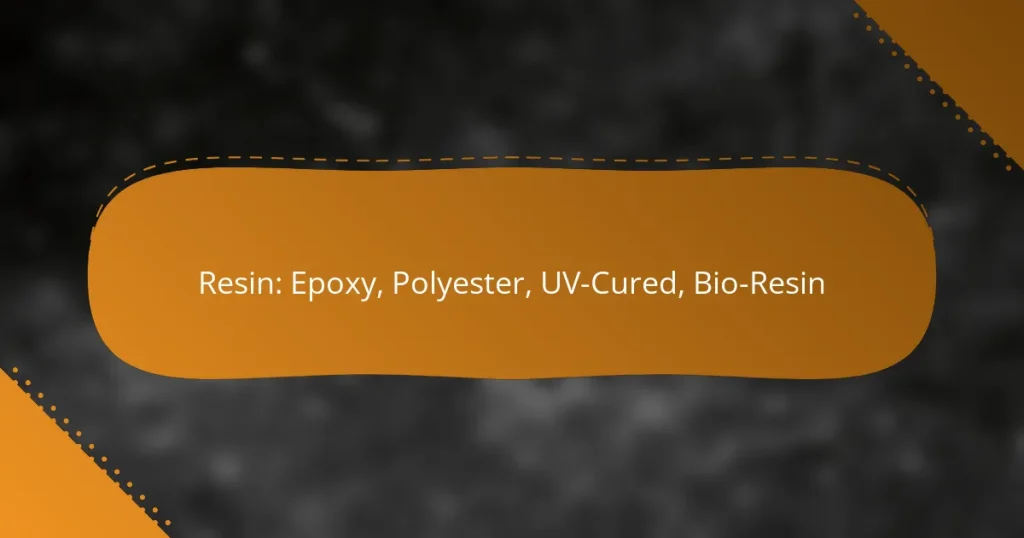Resin materials, including epoxy, polyester, UV-cured, and bio-resin, each offer unique benefits tailored to different applications. Epoxy resin is renowned for its strength and glossy finish, making it ideal for furniture and art, while polyester resin is a cost-effective alternative, albeit with lower durability. UV-cured resin stands out for its quick curing time and environmental resistance, suitable for coatings and adhesives. Understanding these differences can help you select the right resin for your specific project needs.
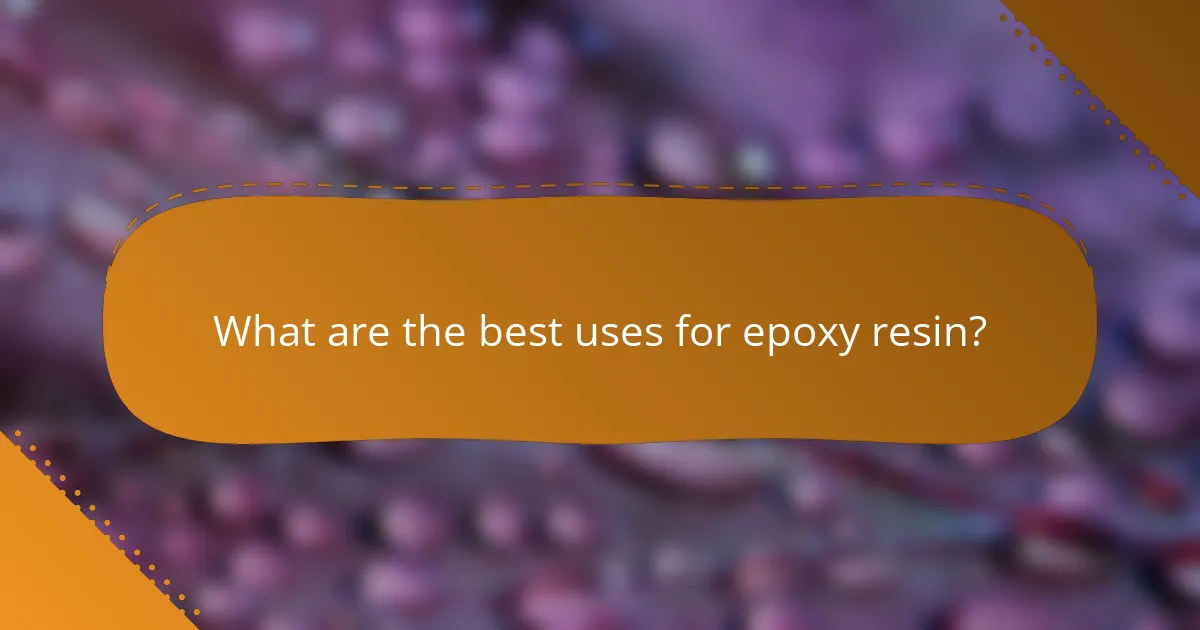
What are the best uses for epoxy resin?
Epoxy resin is highly versatile and is best used in applications requiring strong adhesion, durability, and a glossy finish. Its unique properties make it suitable for furniture making, art, coatings, jewelry, and construction projects.
Furniture making
Epoxy resin is popular in furniture making due to its ability to create durable and aesthetically pleasing surfaces. It can be used to fill cracks, enhance wood grain, or create stunning river tables by combining wood with colored resin.
When working with epoxy for furniture, ensure proper mixing and curing times to achieve the best results. Consider using a heat gun to eliminate bubbles and achieve a smooth finish.
Art and crafts
Artists often use epoxy resin to create unique pieces, including paintings, sculptures, and decorative items. Its clarity and ability to hold pigments make it ideal for encapsulating objects or creating layered effects.
For crafting, it’s essential to work in a well-ventilated area and wear protective gear. Experiment with different colors and additives to achieve desired artistic effects.
Coating and sealing
Epoxy resin serves as an excellent coating and sealing agent for various surfaces, providing a protective layer that is resistant to moisture and chemicals. It is commonly used on countertops, floors, and even boats.
When applying epoxy as a sealant, ensure the surface is clean and dry. Follow the manufacturer’s instructions for mixing and application to avoid issues like bubbling or uneven curing.
Jewelry creation
In jewelry making, epoxy resin is used to create beautiful, custom pieces that can incorporate various materials, such as dried flowers or glitter. Its versatility allows for endless design possibilities.
For best results, use molds specifically designed for resin jewelry and consider adding colorants or embellishments before pouring. Allow adequate curing time to ensure durability.
Construction applications
Epoxy resin is widely used in construction for its strong bonding properties and resistance to environmental factors. It is often utilized in flooring systems, adhesives, and repair materials.
When using epoxy in construction, ensure compatibility with the materials being bonded. Follow safety guidelines and local regulations regarding its application to achieve optimal performance.
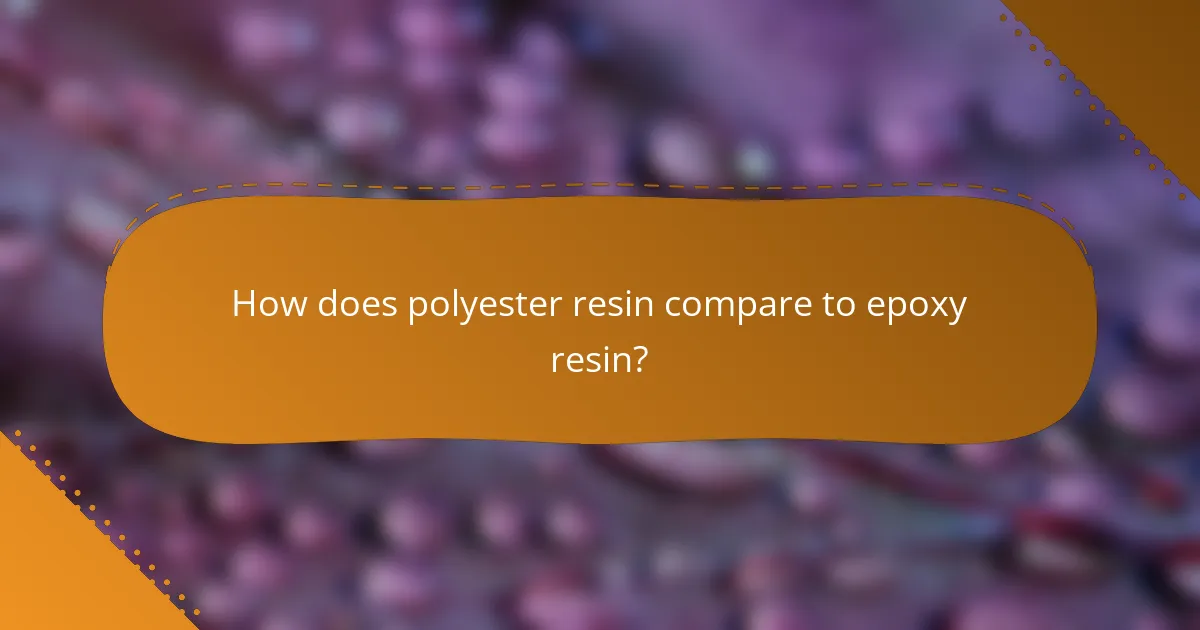
How does polyester resin compare to epoxy resin?
Polyester resin is generally less expensive and easier to work with than epoxy resin, but it lacks some of the durability and chemical resistance that epoxy offers. When choosing between the two, consider the specific requirements of your project, including cost, strength, and application method.
Cost-effectiveness
Polyester resin is typically more affordable than epoxy resin, making it a popular choice for budget-conscious projects. Prices for polyester resin can range from low tens to mid-hundreds of USD per gallon, while epoxy resin often costs significantly more, sometimes exceeding 200 USD per gallon.
While polyester may save money upfront, consider the long-term costs associated with durability and maintenance. If a project requires frequent repairs or replacements, the initial savings on polyester might not be worth it.
Durability
Epoxy resin is known for its superior strength and resistance to environmental factors, including moisture and chemicals. This makes it ideal for applications that demand high durability, such as marine and industrial uses.
In contrast, polyester resin is more prone to cracking and yellowing over time, especially when exposed to UV light. For projects that will face harsh conditions, epoxy is often the better choice despite its higher cost.
Application methods
Both polyester and epoxy resins can be applied using similar techniques, such as brushing, rolling, or spraying. However, polyester resin typically cures faster, which can be advantageous for projects requiring quick turnaround times.
On the other hand, epoxy resin may require more careful mixing and application to achieve optimal results. It is crucial to follow the manufacturer’s guidelines for each type to ensure proper curing and performance.
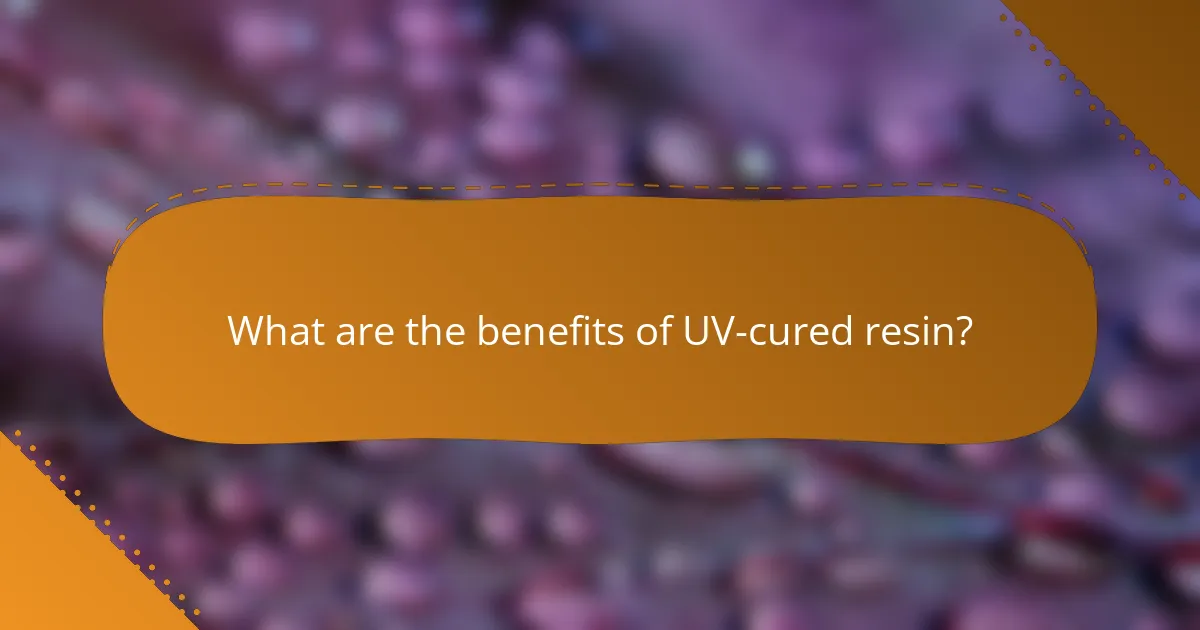
What are the benefits of UV-cured resin?
UV-cured resin offers several advantages, including rapid curing times, a high-gloss finish, and excellent environmental resistance. These properties make it a popular choice for various applications, from coatings to adhesives.
Fast curing time
One of the standout benefits of UV-cured resin is its fast curing time, often taking just seconds to minutes when exposed to UV light. This rapid process significantly reduces production time and allows for quicker project turnaround.
For example, in industrial settings, UV-cured resin can be used to coat surfaces or bond materials without lengthy wait times, improving efficiency. However, it’s essential to ensure proper UV exposure to achieve optimal curing results.
High gloss finish
UV-cured resin typically provides a high gloss finish that enhances the aesthetic appeal of the final product. This glossy surface is not only visually striking but also helps protect the underlying material from scratches and wear.
When using UV-cured resin for applications like jewelry or decorative items, the glossy finish can elevate the perceived value. To maintain this shine, regular cleaning with mild solutions is recommended, avoiding abrasive materials that could dull the surface.
Environmental resistance
Another significant benefit of UV-cured resin is its strong environmental resistance, making it suitable for both indoor and outdoor applications. It can withstand exposure to moisture, UV rays, and various chemicals without degrading.
This durability is particularly advantageous for products used in harsh conditions, such as outdoor furniture or automotive parts. However, it’s crucial to select the right formulation to match specific environmental challenges, ensuring long-lasting performance.
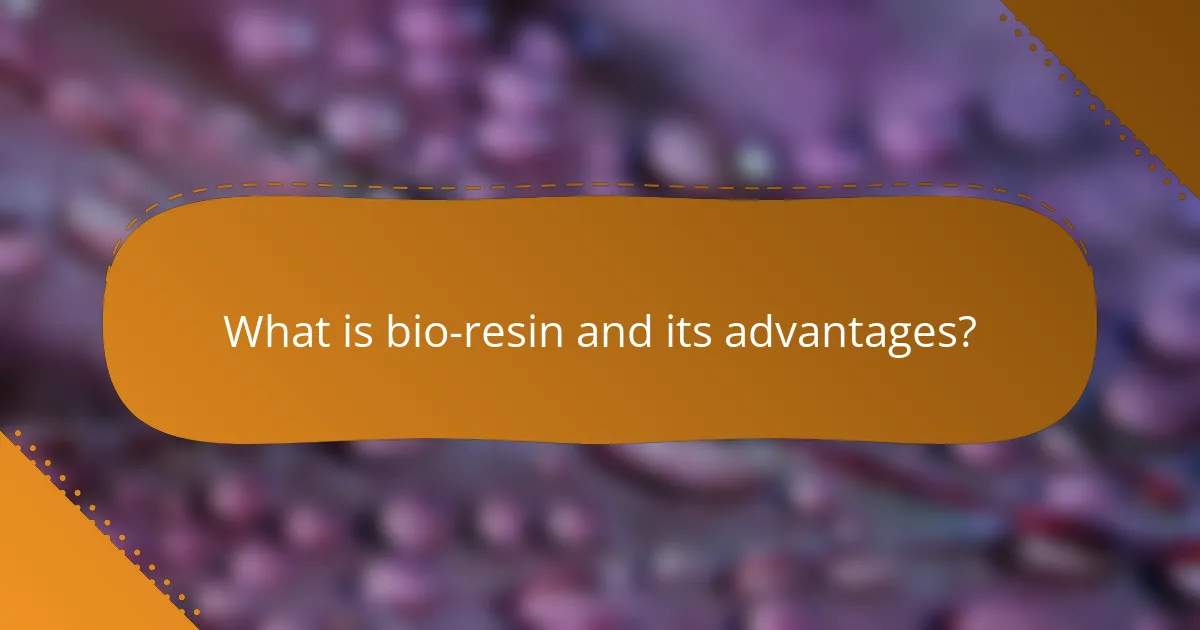
What is bio-resin and its advantages?
Bio-resin is a type of resin derived from natural plant materials, offering a more sustainable alternative to traditional synthetic resins. Its advantages include reduced environmental impact, lower toxicity, and potential for biodegradability, making it an appealing choice for eco-conscious consumers and manufacturers.
Eco-friendly materials
Bio-resins are primarily made from renewable resources such as vegetable oils, starches, and other organic materials. This contrasts with conventional resins, which are often petroleum-based and contribute to fossil fuel depletion. By using bio-resins, manufacturers can significantly lower their carbon footprint and promote sustainable practices.
Many bio-resins are produced using processes that consume less energy compared to traditional methods. This not only reduces greenhouse gas emissions but also supports a circular economy by utilizing waste materials from other industries.
Biodegradability
One of the key benefits of bio-resins is their potential for biodegradability. Unlike conventional resins, which can take hundreds of years to decompose, bio-resins can break down more quickly in natural environments, reducing landfill waste and pollution. However, the specific biodegradability can vary based on the formulation and environmental conditions.
It is essential to consider that not all bio-resins are created equal; some may still require specific conditions to biodegrade effectively. Consumers should look for certifications or standards that indicate a product’s biodegradability, such as ASTM D6400 or EN 13432.
Applications in sustainable design
Bio-resins are increasingly being used in various applications, including furniture, automotive parts, and construction materials, where sustainability is a priority. Their versatility allows designers to create products that are not only functional but also environmentally friendly.
In sustainable design, bio-resins can be combined with natural fibers like hemp or flax to produce composite materials that are lightweight and strong. This combination is particularly valuable in industries looking to reduce their reliance on synthetic materials while maintaining performance standards.

What factors should be considered when choosing resin?
When selecting a resin, consider the project’s specific requirements, the environmental impact, and the cost and availability of the materials. Each factor plays a crucial role in ensuring the chosen resin meets both functional and ethical standards.
Project requirements
Identify the specific needs of your project, such as strength, flexibility, or curing time. For instance, epoxy resins are often favored for their durability and adhesion, while polyester resins may be chosen for their ease of use in fiberglass applications.
Consider the application environment as well. If the resin will be exposed to moisture or chemicals, select a type that offers appropriate resistance. For example, UV-cured resins are ideal for applications requiring quick curing and high resistance to UV exposure.
Environmental impact
Evaluate the environmental implications of the resin you choose. Traditional epoxy and polyester resins can release volatile organic compounds (VOCs) during curing, which may require proper ventilation and safety measures.
Bio-resins are an increasingly popular alternative, as they are derived from renewable resources and often have a lower environmental footprint. However, assess their performance characteristics to ensure they meet your project needs.
Cost and availability
Cost is a significant factor when selecting resin, with prices varying widely based on type and quality. Epoxy resins typically range from moderate to high cost, while polyester resins are generally more affordable.
Availability can also influence your choice. Ensure that the resin you select is readily available in your region, as some specialty resins may require longer lead times or be harder to source. Check local suppliers for options that fit your budget and timeline.
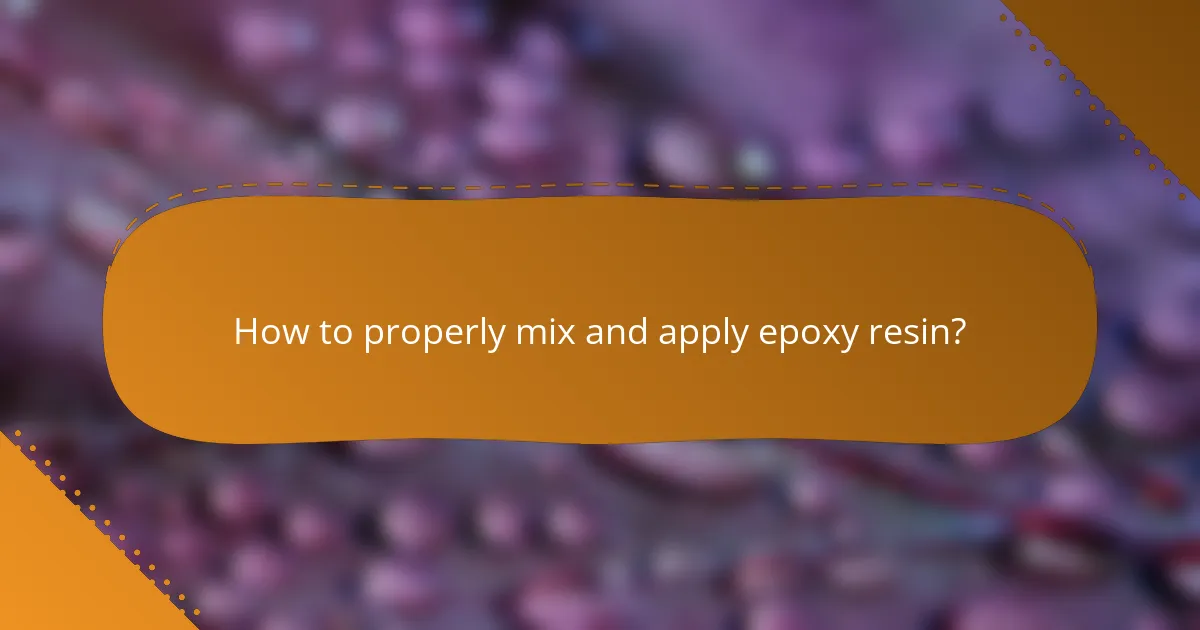
How to properly mix and apply epoxy resin?
To properly mix and apply epoxy resin, ensure you follow the correct mixing ratios and application techniques. This will help achieve a strong, durable bond and prevent common issues like bubbles or improper curing.
Mixing ratios
The mixing ratio of epoxy resin typically involves a resin and hardener component, commonly in a 2:1 or 1:1 ratio, depending on the specific product. Always refer to the manufacturer’s instructions for the exact proportions, as variations can significantly affect the curing process.
When measuring, use precise tools like graduated cups or scales to ensure accuracy. Inaccurate mixing can lead to incomplete curing, resulting in a weaker final product. A common pitfall is eyeballing the amounts, which can lead to inconsistent results.
For best results, mix the components thoroughly for at least 3-5 minutes, scraping the sides and bottom of the mixing container. This ensures that the hardener is fully integrated into the resin, promoting optimal curing and performance.
